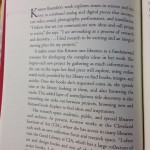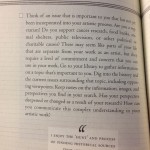A couple of years ago I participated in a project called the Library as Incubator Project. Over 100 artists were asked to answer the question, “What does the phrase ‘library as incubator’ mean to you?” I sent in a statement about my love of libraries and their role in my making process.
The cofounders and editors of the project, Erinn Batykefer and Laura Damon-Moore continued with the project and created a book that features some of the artist stories that they collected in order to suggest new ways that others can use the library to increase productivity, inspire new work, and support a creative life.
I am so honored to be in this book, and to have my writing and images featured in Chapter 3 – Using the Library for Creative Research. What is so cool is that there are exercises with my section – that are meant for the reader to try. (Or I might just try them for a new side project I want to start.)
Here is the official description of the book from the book website:
“Creativity, like information, is free to everyone who steps into a library. An offshoot of the Library as Incubator Project, The Artist’s Library offers that an artist is any person who uses creative tools to make new things, and provides the guidance and resources to make libraries come alive as spaces for art-making and cultural engagement. The book draws attention to the physical and digital collections and resources that may be of particular use to artists and writers, provides ideas for art education opportunities within libraries, and offers practical how-tos for artists and libraries alike. From the crafty (pop-up books) to the community-minded (library galleries); the documentary (photo projects) to the technically complex (“listening” to libraries via Dewey decimal frequencies), the case studies included in the book feature artists, writers, performers, and libraries that embody the “library as incubator” spirit.”
Take a peek at the writing or exercise page below:
The Artist’s Library – A Field Guide – Coffee House Press
Youtube Video of the authors – The authors talk about libraries and artists
The Artist’s Library on Amazon


